The 2013 MacBook Air Review (13-inch)
by Anand Lal Shimpi on June 24, 2013 12:01 AM ESTAbsolutely Insane Battery Life
With Haswell ULT, Intel aggressively focused on driving down total platform power consumption. It turns out that although Intel did a wonderful job of driving down CPU power consumption over the years, it did nothing to make the rest of the platform keep up. With Haswell ULT, all of that changed. Intel is being frustratingly cagey with giving up real details on exactly what’s going on with Haswell ULT, but here’s what I’ve been able to piece together.
For starters, Haswell ULT brings the PCH (Platform Controller Hub) on-package. The PCH is responsible for all SATA, USB, PCIe 2.0 and other rest-of-system interfaces. Bringing it on package reduces the amount of power needed to drive traffic between the CPU and PCH, which in turn helps reduce platform power.
The PCH also moves down to 32nm, helping further reduce power consumption. Haswell ULT silicon itself is binned for lower voltage/power operation. The combination of Haswell ULT CPU and PCH are both included in the new 15W TDP (there’s a 28W version as well but not used in the MacBook Air).
Haswell ULT supports lower power sleep states (up to C10) than the standard mobile or desktop parts (C6/C7).
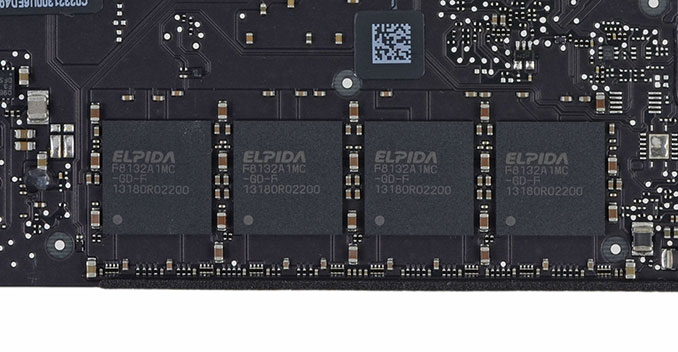
Image Courtesy iFixit
The other big change, and one that Apple is among the first (only?) to take advantage of is Haswell ULT’s support for LPDDR3. Standard DDR3 operates at 1.5V, while low-voltage DDR3L drops that down to 1.35V - the two standards are otherwise identical. LPDDR3 on the other hand drops voltage even further (1.2V) while introducing architectural features to drive power down even lower. LPDDR3‘s power advantage is why it’s frequently used in smartphones vs. DDR3L. The biggest downside is cost. Apple has historically not had an issue with spending a bit extra to get a better overall experience, so it’s not surprising to see the MacBook Air ship with LPDDR3.
Overall bandwidth remains unchanged despite the move to very low power memory. We’re still dealing with a 128-bit wide memory interface with a 1600MHz datarate. Note the impact this has on DRAM device layout on the PCB itself. Last year's model required 16 DDR3L devices, compared to 4 x 32-bit LPDDR3 devices here. Anyone else smell laptop/tablet convergence coming this way?
Haswell ULT also enables support for Intel’s Power Optimizer framework. I’ve talked about this extensively over the past several months, but it’s effectively a messaging system that allows all devices/controllers within a system to coordinate going into sleep states during periods of idle time. Of all of the platform power optimizations, this is the only one that isn’t currently taken advantage of in OS X. You’ll have to wait for OS X Mavericks to realize these gains.
Apple also boosted overall battery capacity on the MacBook Airs by roughly 8%. The increase in battery capacity had no impact on weight. Although it’s not immediately apparent, I would assume that Apple’s new SSDs also support DevSleep (DEVSLP) and Runtime D3.
The result of all of this is a downright tremendous improvement in battery life. OS X already did very well in the idle power department. Haswell’s FIVR (Fully Integrated Voltage Regulator) can more quickly/aggressively enter and exit low power states. The combination of which is really the perfect storm for increasing battery life.
On the 13-inch MBA, Apple claims up to 12 hours of usage on a single charge.
Apple even revised its own testing in order to make its quoted battery life numbers more realistic. Previously it ran all of its own battery life tests at 50% brightness, but starting with the MacBook Air Apple’s quoted battery life numbers are at 75% brightness. Our tests by comparison are at 81.5% (200 nits on the MBA). Apple’s changes to its battery testing methodology actually tend to unintentionally mirror ours. Our first Mac battery life tests ran at roughly 50% brightness (100 nits).
So how did the MacBook Air fare in our testing? To find out I turned to our updated 2012 battery life test suite, first introduced with the 15-inch rMBP review.
The light and medium suites are inherently related - they use the same workload and simply vary the aggressiveness of that workload. The light test hits four different websites every minute, pausing for nearly the entire time to simulate reading time. Flash is enabled and present on three of the sites. The long pause time between page loads is what really makes this a light test. Web browsing may be the medium for the test but if all you’re doing is typing, watching Twitter update and maybe lazily doing some other content consumption this is a good representation of the battery life you’ll see. It’s a great way of estimating battery life if you’re going to be using your notebook as a glorified typewriter (likely a conservative estimate for that usage model).
The medium test hits the same webpages (Flash and all) but far more aggressively. Here there’s less than 10 seconds of reading time before going onto the next page. It sounds like a small change but the impact on battery life is tremendous.
Both the light and medium tests are run in their default state with processor graphics enabled, as well as with the discrete GPU forced on. I run with the dGPU on as well because it’s far too often that a single application open in the background will fire up the dGPU and contribute to draining your battery. The goal here is to deliver useful numbers after all.
The final test is very similar to our old heavy multitasking battery life tests, but with some updates. Here I’m downloading large files at a constant 1MB/s from a dedicated server, while playing back a looped 1080p H.264 movie (the Skyfall trailer) all while running the medium battery life test. The end result is a workload that gives you a good idea of what a heavy multitasking usage model will do in terms of battery life. I’ve found that OS X tends to fire up the dGPU anyway while running this workload so I saw no reason to run a separate set of numbers for processor and discrete graphics.
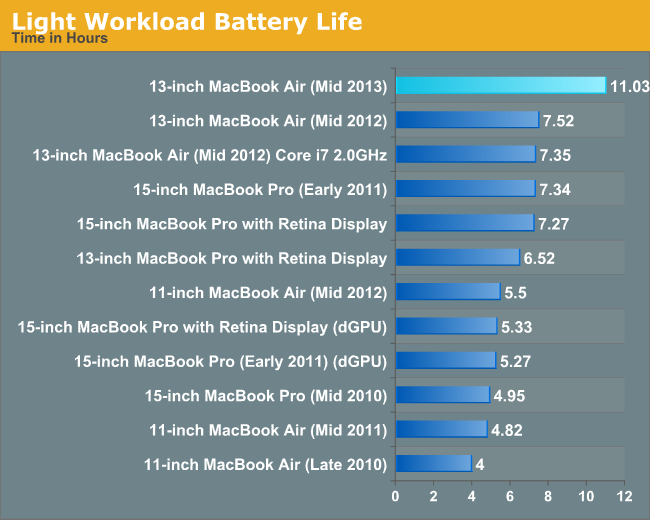
This is just ridiculous. Apple claims 12 hours, we tend to test a little more strenuous than Apple does and ended up with just over 11 hours of battery life on a single charge. These highly idle cases end up dominated by display power, which is why we actually see the smallest improvement in battery life over the previous generation here (~35%, normalized for battery capacity). If you drop brightness down to something more reasonable (~100 nits) you’ll get some truly insane numbers:
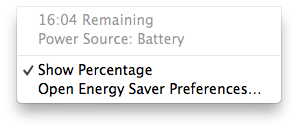
I remember owning a Transmeta Crusoe based Sony Picturebook (C1VN) with an extended battery and being able to break 14 hours of battery life. I had to give up so much performance and usability to get that sort of battery life back then; with the new MacBook Air, I don’t have to.
Now this is really the sort of battery life you can expect when using the 13-inch MBA as a glorified typewriter. What happens if you start using the system a bit more aggressively?
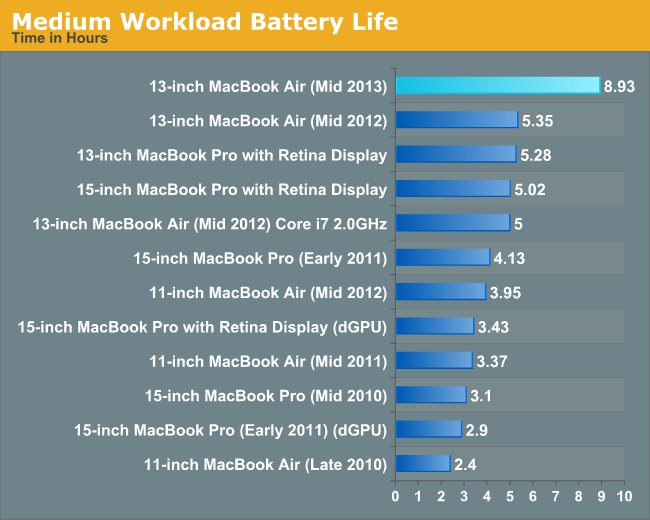
Just under 9 hours on a single charge, an increase of 54.5% when you normalize for battery capacity. What the world would’ve done if Haswell ULT hit prior to the creation of the iPad...
The reason I create/present three different battery life tests is to showcase a range of expected battery life. No one number is going to characterize what you can expect out of the system, but my hope is you’ll get a good idea of range by looking at the numbers here. The heavy test used to provide a good look at worst case scenario, but I’m beginning to wonder if I need something even more stressful:
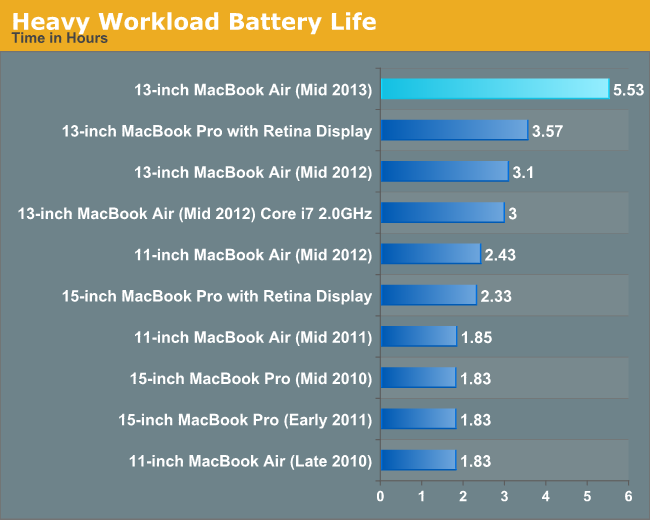
Even normalizing for battery capacity changes, the new 13-inch MacBook Air increases battery life by 65% over the previous model.
Under really heavy use (think tons of video/photo editing work) you can go even lower than what our heavy workload numbers show. In my experience I found that around 7 hours of battery life on a single charge is reasonable for most of my workloads, but when doing a lot of work (tons of Flash tabs open, compiling a project in the background and heavy multitasking) I could kill the 13-inch MBA in under 4 hours.
The benefit of the new MBA is really in its ability to extend its battery life when needed. Close Safari windows, turn down the brightness, and you’ve got a machine that can last for a very long time without needing a wall outlet. There's a good reason that OS X Mavericks focuses so much on putting background tasks/apps to sleep, maximizing idle time is really the key to getting this insane amount of battery life.


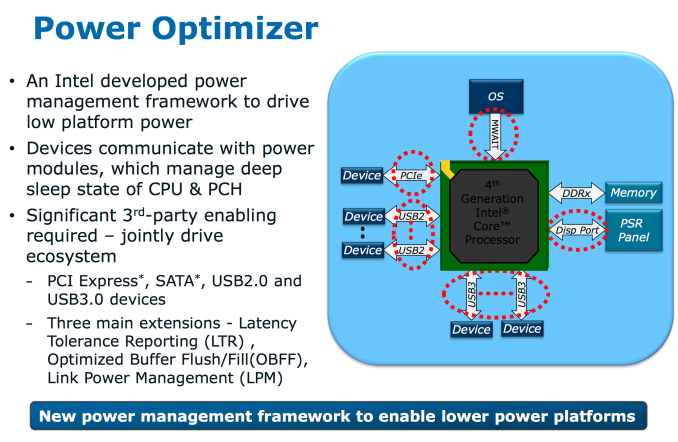








233 Comments
View All Comments
vol7ron - Wednesday, June 26, 2013 - link
I'm sorry, have you ever owned an MBA? You don't want to be doing any heavy development on this device, it will get hot fast.This device should be the Traveler's Laptop: good enough to carry with you, more productive than an iPad, full keyboard, longer battery life than a regular laptop, lighter weight, and a few ports to maybe support what you need. It would be perfect for a plane or train, maybe to lounge by the pool, but should not be considered as a desktop or MBP replacement.
The shame of it is that it's so portable, that it leaves you wanting to do more with it. It almost has done it's job too well. In that regard, you are right, it is lacking the things that would put it over the edge, that would make it a replacement of the desktop/MBP, which again it's not. But be conscious that [I think] this has no fans, and from when I used it, got hot really fast -- horrible for any extreme development, or even long-term gaming.
darwinosx - Monday, July 8, 2013 - link
Hah! Lots of developers use Airs without issue.cscordo - Thursday, August 8, 2013 - link
What a ridiculous comment from someone who clearly doesn't develop software.I'm still on a 13" MBA from two gens ago and run multiple IDE's and SQL Server 2010, and it doesn't skip a beat.
What type of "heavy" software development do you perform that it can't handle? I'd be very interested to know.
josef195 - Tuesday, August 20, 2013 - link
So, you're saying the Macbook Air isn't for pro users? I must say, if only they had some Macbook for professional users; they could even call it a Macbook Pro.Calista - Thursday, June 27, 2013 - link
I agree with your ideas of adding the option of 16 GB of RAM and 4G support. Virtualization is growing all the time, the memory usage can grow very quickly if starting to run a few VM in parallel. And not having the option of 4G in this day and age is just embarrassing. For a machine *built* to be used on the go, with every component (battery life, weight, size) adopted to this task not adding 3G/4G just doesn't make sense.Dave DeCo - Saturday, June 29, 2013 - link
I have never given much thought to the 4G thing. But now that it's brought up I too wonder why the MBA doesn't offer it. My incredibly portable iPad has it. iPhone too of course. Why not the wafer thin MacBook Air? Oh Apple. Always dangling that carrot on the longest stick possible while telling us we don't need carrots. If that last line makes sense to anyone please tell me. Because I don't know what the Helsinki I just said.australianm8 - Saturday, July 6, 2013 - link
A few considerations for everyone fussing about 4g support.1. Apple likes to keep a simple product line
2. Look at a teardown, not much room in there for much more to add. (already pushing it's thermal limits)
3. There are a plethora of cell carriers that offer 4g USB sticks
darwinosx - Monday, July 8, 2013 - link
That was a childish and ignorant display of petulance. Obviously a particularly immature teenager.jaycee1970 - Saturday, August 24, 2013 - link
"Dump your apple stock now, it will bounce back"Wow, that's fantastic financial advice, genius. I'll definitely sell something that will go up in value. The rest of your post was just as intelligent. Thank you.
othernet - Monday, November 4, 2013 - link
Uhm... there are hybrid notebook/tablets out there. Did you buy one? I don't know of anyone that did.Apple sells Retina 4, 10, 13 and 15 inch products. Soon, an 8 inch product too. You must have missed the keynotes.
Wireless charging? Wait, do you still need to plug the wireless charger somewhere to make it work? When it doesn't have to sign me up!